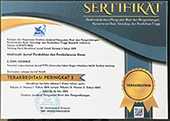Penyesuaian Diri Anak Luar Biasa (Studi Kasus Ade Irawan, Juara Pianis Tunanetra Indonesia)
Abstract
Adjustment is the ability of individuals to associate with them self and environment. Children have experience growth and development in her both physically and mentally, covers an area ofmotor/biological, cognitive, and emotional development/affective/social. Growth in this area lasted
three continuous and sustainable for the human growth process. During the process, begin a familiar term exceptional children, because of different developmental processes. In mental health, the children will remain
outstanding face demand adjustment interact, work, education, married, gave birth to off spring. The children are exceptional (1) Child mental disorders, include a) children who have unusually high intellectual capacity (intellectually superior), and b) the kids are slow to learn (Mentally retarded), (2) sensory disorders, including children with a) damage to hearing (auditory impairments), also known as hearing impairment, b) impaired vision (visual impairments), also known as the blind, (3) communication
disorders, a) learning disabilities (learning disability), b) in speech and language disorders (speech and language impairments), (4) behavioral disorders , including: a) emotional disorders, b) Incompatibility of social behavior or tunalaras (social maladjustment), (5) tunagrahita or severe
disability, covering a variety of disabilities such as CP combination with mental retardation, visual impairments with mental retardation. Focus questionsis What is the process through which the development of Ade Irawan in life. Qualitative research methods, with secondary data from a number of sites biography Ade Irawan, analyzing various body language, personal statements subject, as well as the statements of parents, and people nearby. Results showed that developments Ade Irawan is formed as follows: (1) parental support, (2) high level of intelligence, (3) music
talent, forming a positive self concept, (4) conversion of audio viasualisasi dominant senses, (5) the character general visual impairment: high alert attitude on the new people, brave and critical.
Keywords: Adaptation, Excellent child, Blind people
three continuous and sustainable for the human growth process. During the process, begin a familiar term exceptional children, because of different developmental processes. In mental health, the children will remain
outstanding face demand adjustment interact, work, education, married, gave birth to off spring. The children are exceptional (1) Child mental disorders, include a) children who have unusually high intellectual capacity (intellectually superior), and b) the kids are slow to learn (Mentally retarded), (2) sensory disorders, including children with a) damage to hearing (auditory impairments), also known as hearing impairment, b) impaired vision (visual impairments), also known as the blind, (3) communication
disorders, a) learning disabilities (learning disability), b) in speech and language disorders (speech and language impairments), (4) behavioral disorders , including: a) emotional disorders, b) Incompatibility of social behavior or tunalaras (social maladjustment), (5) tunagrahita or severe
disability, covering a variety of disabilities such as CP combination with mental retardation, visual impairments with mental retardation. Focus questionsis What is the process through which the development of Ade Irawan in life. Qualitative research methods, with secondary data from a number of sites biography Ade Irawan, analyzing various body language, personal statements subject, as well as the statements of parents, and people nearby. Results showed that developments Ade Irawan is formed as follows: (1) parental support, (2) high level of intelligence, (3) music
talent, forming a positive self concept, (4) conversion of audio viasualisasi dominant senses, (5) the character general visual impairment: high alert attitude on the new people, brave and critical.
Keywords: Adaptation, Excellent child, Blind people
Keywords
Adaptation, Excellent child, Blind people
Full Text:
PDFDOI: https://doi.org/10.18860/jt.v6i2.3315
Copyright (c) 2016 MADRASAH





